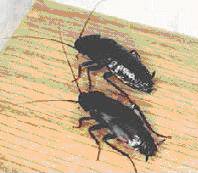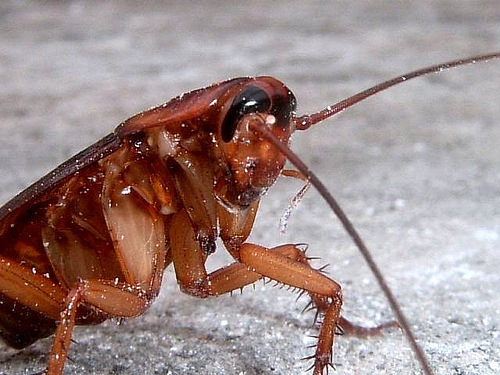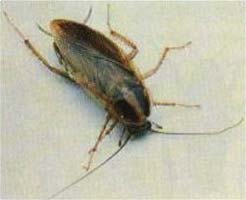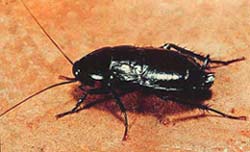Advanced Pest Control Services
(Part of the Sussex Technical Products Group)


Cockroaches in Food Businesses
To control cockroaches, you need a regular pest control treatment programme
with a reputable private company.
This leaflet includes advice on what you can do to help prevent problems arising
.
Description
Generally two pairs of wings, although these may be reduced or even absent,
forewings have well developed veins and tend to be hardened, they overlap
down the mid-dorsal line; membranous hindwings are folded below forewings;
long whip-like, many-segmented antennae; omnivorous, with mouth parts adapted
for biting; 5-segmented body; incomplete metamorphosis, with egg and nymph
stages. There are two common species: GERMAN or ORIENTAL

German Cockroach (Blattella germanica)
Adult, 10-15mm long, yellowish-brown colour with two longitudinal dark marks;
wings well developed in both sexes; can readily climb rough and polished vertical
surfaces.

Oriental Cockroach (Blatta orientalis)
Adults, 20-24mm long; dark brown/nearly black colour; wings of male cover
two-thirds of abdomen, females do not have developed wings; unlike the German
variety, can climb rough but not the smooth vertical surfaces often used in
food rooms. Nymphs (young) The nymphs of all species are similar in appearance
to the adult, but smaller. Immediately after hatching or moulting the nymphs
are white, but the cuticle soon darkens to the normal colour.
Distribution
Cockroaches are common in commercial premises
associated with the production or handling of food. Also in public buildings
and domestic premises, eg. apartment
blocks. Gregarious and nocturnal, they spend the day hiding in cracks and
crevices around such areas as sinks, drains, cookers, the backs of cupboards
and in refrigerator motor compartments. They especially favour buildings with
service ducts and complex plumbing installations. Infestations may be introduced
as egg cases or adults in incoming laundry, on raw materials, in crates and
packaging, or arise as the insects enter buildings via such routes as drains
or refuse chutes.
Public Health Significance
Cockroaches can cause the spread of diseases
such as dysentery, gastroenteritis, typhoid and poliomyelitis. Their diet
is omnivorous and includes fermenting substances, soiled septic dressings,
hair, leather, parchment, wallpaper, faeces and food for human consumption.
Food may be contaminated either by the mechanical transfer of causative agents
of disease from the insect's body, or by transmission of the faeces. Cockroaches
and their faeces may cause allergic reactions, especially amongst sensitive
individuals, eg. asthmatics. Exposure may result from ingestion or through
the inhalation of materials derived from cockroaches in airborne dust. In
addition, food may be tainted with the characteristic smell of cockroach,
which is produced by faeces and salivary/abdominal gland secretions, or by
the dead insects.
Control Measures – How Can You Help?
Hygiene/management
Prevention should always come before cure. A high standard of hygiene is important
in the control of cockroaches and involves the following components:
• Deny access to food and water
Ensure foods are stored in containers with close fitting lids, and promptly clean and remove spillage, crumbs and waste. This will increase cockroach activity and movement making them more likely to encounter insecticides.
• Deny access to harbourage
Deny access to all potential harbourage in buildings or equipment which would otherwise provide hiding places, ensure service pipes or conduits passing through walls, are effectively sealed and panels tight fitting. Promptly remove any redundant equipment from food preparation rooms. Buildings and equipment should be designed to minimise the accumulation of debris and facilitate ease of cleaning. Keep drains and refuse areas well maintained. Surveillance of incoming goods and materials including packaging and laundry.
• Environmental controls
Cockroaches like warm,
moist environments. Keep food rooms well ventilated. Ventilation accelerates
dehydration of the insects and
interferes with the operation of their antenna.
4 Frenchgate Close , Eastbourne. East Sussex. BN22 9EX. United Kingdom.
Booking Hotline and Technical advice 07767148143 or 01323 365124 Office
meshsales@skylord.f2s.com
Copyright © 2014 Sussex Technical Products